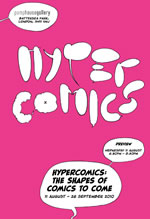Hypercomics:
The Shapes Of Comics To Come
‘A hypercomic can be thought of as a webcomic with a multi-cursal narrative structure. In a hypercomic the choices made by the reader may influence the sequence of events, the outcome of events or the point of view through which events are seen… it’s that element of reader choice and interaction that makes a hypercomic a hypercomic.’
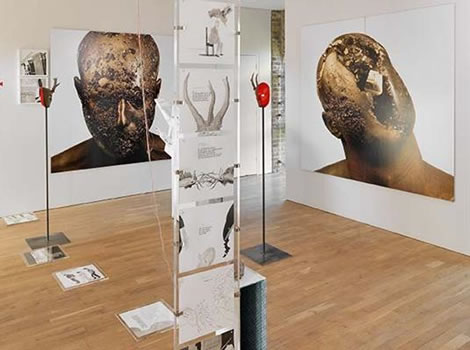
‘The Rut’, a new work by Dave McKean at Hypercomics
This is British comics experimenter supreme Daniel Merlin Goodbrey’s definition of hypercomics which helped to inspire and underpin the exhibition I have curated about them for the Pump House Gallery in London’s Battersea Park, continuing until 26 September. I will be giving an illustrated talk there about the show and its concepts on Wednesday 15 September, 7pm, as part of the SW11 Literary Festival, entitled More Than Words Can Say: The Future Is Graphic. For me, the key to Hypercomics is their ability to branch off into multilinear yet interrelated storylines and push against the traditional constraints of the page format, reading order or panel layouts we’re used to. Comics have been defined for so long by their print incarnations, and even now most webcomics conform to individual ‘pages’ within the standard rectangular computer screen. Hypercomics explore where the medium might be heading next, especially with the growth of iPhones, iPads and other Readers and the scope of greater interactivity. I’m convinced that there’s massive potential still to be unlocked in how we create and experience ‘the shapes of comics to come’.
Download the Hypercomics iPad app for free in the iTunes App Store.
So how did this project come about? Exhibitions Officer at Pump House Nick Kaplony knew about the Comica Festival and contacted me about a year ago to start developing a comics-related show. From a long list of candidates, the four artists were selected to create contrasting content. To secure the funding, at least one of the four had to come from exhibiting in the contemporary art gallery scene, so that was one criterion that brought in Adam Dant. I was aware of Dave McKean’s and Warren Pleece’s previous gallery-orientated projects along these lines - Dave’s Coast Road show in Rye and Warren’s Montague Terrace digital media show in Brighton - and thought they would be ideal. And from the outset I wanted Daniel Merlin Goodbrey as the UK’s true techno-wizard of rigorous comics experimentation. Daniel was closely involved back in 2003 at the start of Comica with the still-remarkable collaborative PoCom or Potential Comics wall which was shown in the ICA Concourse Gallery. You can see it here.
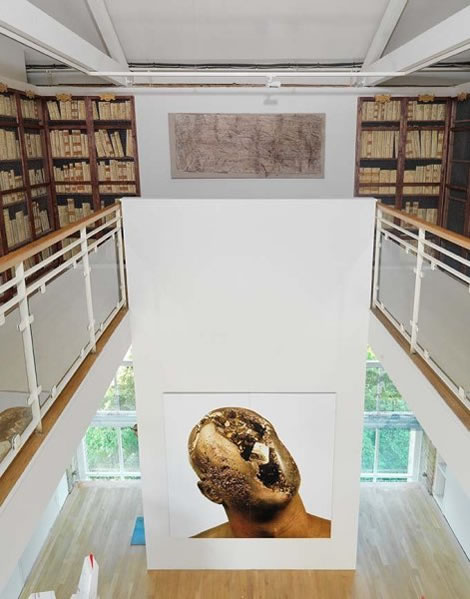
The view from Adam Dant’s top-floor mezzanine down onto McKean’s work
Photo by Alex Delfanne
I was already aware of the Pump House Gallery as a unique location, a hidden gem, a quirky four-floor tower tucked away in Battersea Park. In fact, it really was a huge tall pump house built in 1861, 250 years ago next year. The location came first and I saw it as defining the exhibition, as both a space and a setting. I asked all four artists to respond in some way to it in their pieces, imagining their stories around it, creating an alternative existence, past, present or future, for the building. The other proviso behind the Hypercomics exhibition was to encourage the artists to explore different forms and formats of comics. During their print incarnation, comics have conformed to the page and book, but their origins go right back to the very first art galleries, caves. What happens when we liberate comics from the confines of the standardised uniform page and the system of reading only one, singular story from beginning to middle to end?
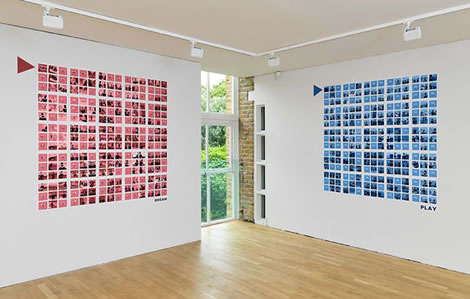
Two of Daniel Merlin Goodbrey’s multi-path ‘Archivist’ walls
As well as looking back to the births and roots of comics, we’re rushing into the digital age now and this transition is opening up other spaces and formats for comics to develop in. Webcomics are a major seedbed, hothouse and testlab for creators to nurture their comics and build up a worldwide audience. But there’s no inherent reason to restrict webcomics to the shape of the computer or iPad screen or shape them for an eventual, inevitable book publication. Out of the online comics community have emerged alternative formats and readings, unlocking the potential of what Scott McCloud, US guru-theorist of Understanding Comics, called ‘The Infinite Canvas’.

The idyllic setting of The Pump House Gallery in Battersea Park
Hypercomics taps into yet another evolution of comics as ‘Gallery Comics’, an art world trend which is seeing artists conceive comics from the outset and sometimes exclusively to be shown and experienced in a gallery setting. This too offers exciting opportunities to immerse the reader/viewer within the comics and use 3D objects and props and other devices to engage and communicate. Clearly gaming, from role-playing multiple choice to the access to different levels and lives, has also been a huge influence on many creators and readers of comics, above all by allowing the reader/viewer/player to interact and drive the story, and offering a variety of different outcomes, not just one reading and one ending.
Out of all these trends, Hypercomics is emerging as the term for experimental comics which present stories with multiple branches or pathways, creating echoes and resonances between them, or several different perspectives on the same character or event, and at more than one moment or time period. Comics has always been a peculiar medium, in that it lets us see past, present and future all at once, from panel to panel, page to page, unlike the pictureless prose novel or a time-locked, durational, image-by-image ephemeral movie, TV show or play. With comics, we can grasp the whole and explore and move about within it, looking back, looking ahead. Hypercomics allow comics to expand on this property and transform visual/verbal storytelling yet again for the 21st century.
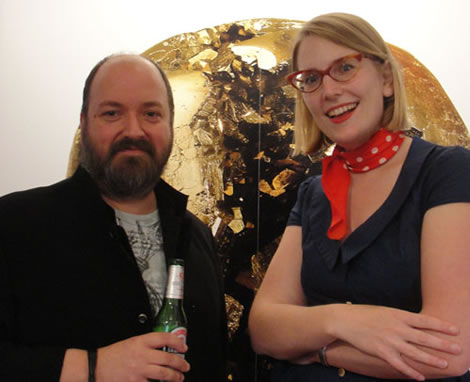
Dave McKean with Sarah McIntyre at the opening night
The Pump House Gallery plays a part in the narrative of the story, three floors and a mezzanine on top, converted from a Victorian pump house next to a boating lake in London’s mostly sublime Battersea Park. So as curator I wanted each artist to use the venue as a setting for their stories, a springboard for ideas. Warren Pleece has imagined the building as the first stage of a conversion into a huge apartment block, Montague Terrace. He has even designed an advert for the sandwich board outside the gallery inviting visitors to view the first phase of the ‘deluxe, moderne apartments’ on show inside. Meanwhile, Daniel Merlin Goodbrey transforms the building into an archive of a glam-rock star turned world dictator. Dave McKean’s ‘The Rut’ responds to the setting itself and the views from the Pump House itself to extrapolate an assault in the park and relate this to the former Deer Enclosure nearby. Adam Dant converts his top floor ‘attic’ into urban magician Dr. London’s late Tudor library of arcane books. Personally, I enjoy how distinctly different each artist’s contribution has turned out and yet how they subtly interrelate.
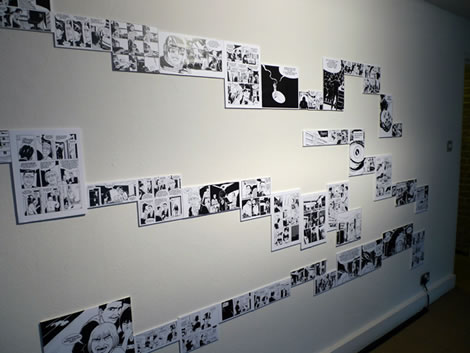
Part of Warren Pleece’s ‘Montague Terrace’ installation
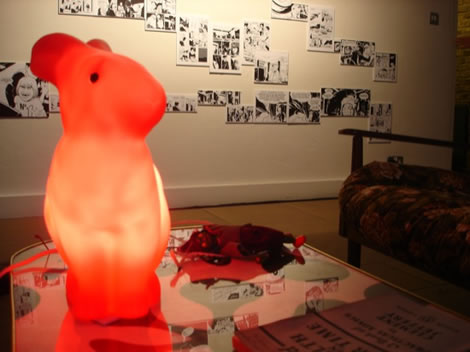
A glowing ‘Marvo the Magic Bunny’
In each case, the audience can interact with the Hypercomics and follow different narrative paths. Pleece invites the public to press a door buzzer and spy on one of four bizarre tenants in his block of flat, while becoming a tenant themselves sitting on a sofa in a fifth flat. Goodbrey presents three grids of multi-nodal diaries about the work, play and dreams of a lone archivist. McKean unfolds an assault from the viewpoints of perpetrator, victim and witness, their stories branching off literally around the gallery, and then asks visitors to look through three masks at the story again, revisited in later life as the truth becomes distorted and ambiguous. Dant displays Dr. London’s historic map of London overlaid with the outlines of a foetal body, the city’s streets as arteries. Visitors can then relate different parts of the capital with their corresponding parts of the body, which are the subjects of a series of bookcases painted in oils with trompe l’oeil spines and their surreal titles. In a final exhibit outside the gallery, comic artists Sean Azzopardi, Joe Decie, John Cei Douglas, Ellen Lindner, Douglas Noble and Paul O’Connell have taken over the Boating Shelter nearby to paste up eight different short comic strips about a fictional 1974 gig supposedly held at Battersea Park’s bandstand by Goodbrey’s megastar Hieronymus Pop. These are printed large like rock concert posters and pasted up on the eight sides of the shelter, can be read in any order.
Hypercomics is very much a physical ‘Hi-Touch’ experience of site-specific comics you have to see in person, in situ, in context. In addition, in the zine tradition, there’s also a limited edition photocopied compilation of all of the Hieronymus Pop strips, plus four unexhibited extras, available from the gallery, and instead of the usual rather dull A5 exhibition flyer produced in-house, Hypercomics is being promoted through a free 12-page newspaper ‘comic’, an artists’ commission drawn and designed by the collective Le Gun; you can take a peep inside it here. That said, we are also developing with the artists some related virtual offshoots, for example on a special Hypercomics website where the public can submit their own responses to the four exhibits to expand aspects of each storyline. The fourth glass wall of Daniel Merlin Goodbrey’s gallery consists of simply this link to his website where throughout the show he is adding new entries about the life of Hieronymus Pop. Also we are working with design team redrawn to produce introductory apps for the iPad as free promotions to present the four artists’ branching storylines and to investigate the iPad’s potential as a vehicle for Hypercomics.
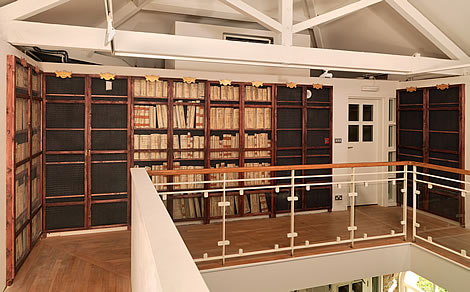
Adam Dant’s library of bizarre trompe l’oeil tomes
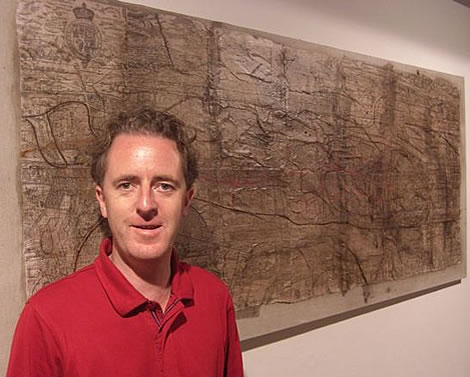
Adam Dant with Dr. London’s corpo-geographic map of the city
Still, for all these newfangled technical advances, there will always be something special and covetable about the printed or physical object of the comic that can’t be experienced digitally. The comic appeals as tactile art object, with the feel of paper, the aroma of ink, the ease of flipping through pages, something to hold, all of this remains very special. So McKean’s ‘The Rut’ will reappear in the second volume of his short comics compendium, Pictures That Tick, while both Goodrey’s and Pleece’s works are intended for eventual print publication. The book has always been wonderfully interactive. Far from replacing print, the internet seems to be leading to more beautifully designed and produced books, and notably graphic novels, for example those by Chris Ware or Seth. Even where entire comics are available for free online, many people still want to own the same content in printed form.
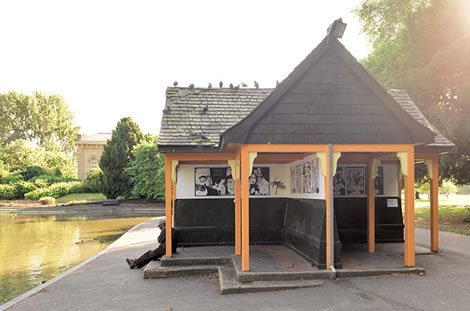
‘Hieronymus Pop’ strips pasted onto the nearby boating shelter
This Hypercomics exhibition hopes to suggest new avenues for the comics medium and how it can relate stories and relate creators with consumers, and vice versa. I think more and more people realise that there is a far broader spectrum of content and art styles to comics than The Beano or Batman, not that there’s anything wrong with either of those. The problem is that many comics end up looking and reading almost exactly the same - whether it’s superheroes, zombies or Sherlock Holmes - because many people like these familiar tales, good vs. evil, boy meets girl, hero defeats villain, stories as old as time, genres as rituals and comfort zones. While these tropes can give us an amazingly rich foundation of storytelling, comics use pictures, and pictures and words, offering such a vast range of text and images to draw upon when creating graphic narratives. With Hypercomics I wanted to see what happens when we let comics escape overfamiliar, well-worn yarns and chart fresh territories. I hope it gives some ideas of what lies out there, where this still evanescent, ever-nascent medium is heading. Take time and I hope you’ll find this content-rich show surprising and rewarding.
Posted: September 5, 2010This article is adapted and expanded from my answers to e-interviews by Laura Havlin at Dazed Digital and Dan Fish at Mindless Ones (thanks for the questions!).













